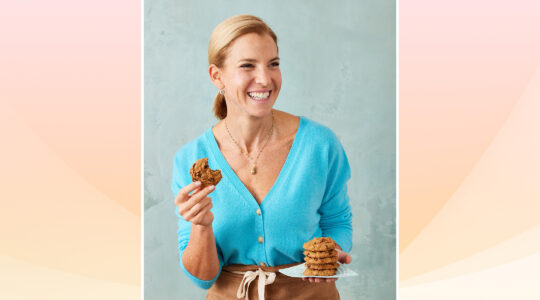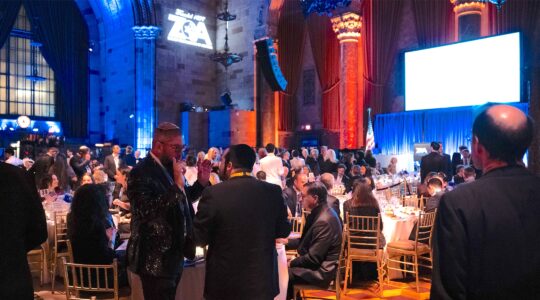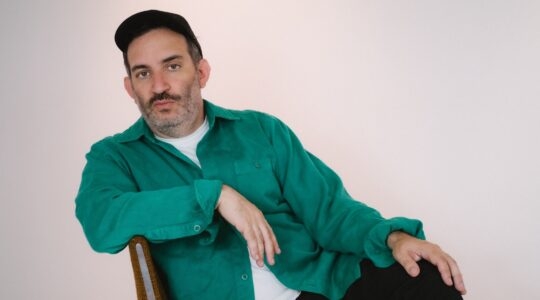And the coffee and danish shall bind them.
Fueled by demographic changes on Long Island’s South Shore and in a bid to stay afloat, members of a Reconstructionist congregation sold their building in Hewlett in 2012 and began renting space in a Reform synagogue in Rockville Centre. At first, it was every shul for itself: Congregation Beth Emeth, the Reconstructionist synagogue, and Central Synagogue, the Reform one, held separate Sabbath services, Hebrew school classes and other programs.
Then the idea emerged to have the two shuls coordinate the times of their Friday services so they would both end at the same time. The goal: to foster a joint Oneg Shabbat, or informal gathering. But the coffee and desserts were set up on the tables in the Central Synagogue meeting hall, and, not surprisingly, congregants from each shul would congregate with their own.
Then, in an experiment in social engineering, the dessert and coffee were placed at one end of the room. Geography, it turned out, was destiny.
“It was set up like a coffee house with different flavored coffees, and they asked people to bring in mugs to replace the cups and saucers,” recalled Ann Van Praag, a member of the Reconstructionist Congregation Beth Emeth.
“Each week the mugs were stacked in a corner and people chose different mugs,” she said. “Someone holding a beautiful one told me she tried to get that one each week. People would talk about the different mugs — it definitely was an icebreaker.”
That “icebreaker” paved the way for what would become a new, and more symbiotic, relationship between two synagogues with theological and stylistic differences. And it is one that could be seen as a model for the large number of other congregations facing similar situations.
After a year of separate services and programs — essentially a house of worship divided — the Oneg convinced the leadership of Beth Emeth and Central Synagogue that such an approach was not sustainable.
“Our leadership realized that the era was over when South Shore communities two miles apart would each have their own Reform, Conservative and Orthodox synagogues,” said Rabbi Elliot Skiddell, Beth Emeth’s spiritual leader. “That model is not going to work here any longer.”
Louise Skolnik, Central Synagogue’s president, said the two congregations decided to form a true partnership and begin actively reaching out to the unaffiliated.
“We are willing to take chances and risks and be flexible,” she explained.
So they began developing joint services and programming that Skolnik said has “energized” their members. “We saw there was more bringing us together than separating us,” she said. “And the two rabbis developed what is beyond collaboration — there’s a synergistic relationship between them.”
Support the New York Jewish Week
Our nonprofit newsroom depends on readers like you. Make a donation now to support independent Jewish journalism in New York.
As part of the new approach, they revamped Friday night programming and it quickly resulted in a doubling of attendance to between 80 and 100 congregants, according to Rabbi Marc Gruber, spiritual leader of Central Synagogue.
In addition to a holding a liberal religious service with music in the cavernous 520-seat sanctuary, an alternative program was created in another area of the three-story 80-year-old building. One week the alternative program explored poetry in Judaism, another week there was guided meditation, and another was devoted to an exploration of modern ethical dilemmas.
Margaret Muser, an elder law paralegal and a member of Central Synagogue, said she likes having a choice each Friday night. She said she has enjoyed the guided meditation as well as the religious service.
“To me it seems like a good mix,” she said, adding that she particularly liked what she called the “homogenized prayer” service that includes “elements of both” the Reconstructionist and Reform prayer books.
“I think it’s a good thing and it appears to be beneficial for both congregations,” Muser, 70, said. “There are times when we use their prayer book and sometimes we use ours. …We have gotten to know Beth Emeth congregants and it has been terrific. We are also trying to reach out to Jews in the area who are unaffiliated, and a part of that is our alternative program.”
The two rabbis now take turns leading the religious service and the alternative programs, which Rabbi Gruber said are designed to “meet the expressed needs of those in the wider community. They are cultural, spiritual and intellectual.”
The alternative program is still evolving. In response to the request of attendees who asked that it contain “elements of Shabbat,” such things as the Shabbat candle lighting, prayers for healing and the mourner’s Kaddish have been added.
Van Praag, 67, a medical records clerk, said she has found the congregations very supportive, especially after the death of her husband a few months after she joined.
“It was like a new family,” she said. “And on a Saturday morning service after Rabbi Gruber read a poem about hugs, he saw me crying and came down [from the bima] and gave me the biggest hug. It meant so much to me. … These are very warm and accepting people.”
Just as congregants came together, so did their Hebrew schools. Now called the Jewish Experience, the consolidated school has an enrollment of 80 youth and uses the Reform movement’s core curriculum augmented with the Reconstructionist’s curriculum.
Larry Kalvar, president of Beth Emeth, stressed that all of the changes were made while “respecting each others traditions and learning each other’s traditions — growing as a result.”
On Saturday mornings there is just one service that combines elements from both prayer books. Skolnik, who was raised in a Conservative household, said she is hearing prayers she was raised with but sees “more similarities and no dissonance” between the traditions of the two formerly independent congregations.
Support the New York Jewish Week
Our nonprofit newsroom depends on readers like you. Make a donation now to support independent Jewish journalism in New York.
Rabbi Skiddell said there is a “tremendous comfort level” during the services and that congregants are encouraged to wear a tallit or a kippah if they wish, and to stand for particular prayers if that is their custom.
Central Synagogue has 250 member families. Beth Emeth, founded in the 1950s, had about 400 member families in the 1960s. Membership at Beth Emeth plunged thereafter and in the 1990s, when there were just 48 families left, the congregants voted to become Reconstructionist. Membership doubled but was down to about 60 at the time it sold its building. Since the move, membership at both congregations has remained constant.
Helping to pull together the two congregations with their somewhat different religious theologies was UJA-Federation of New York, whose Synergy program awarded grants to congregations in 2012 to congregations willing to collaborate.
“We applied for it hoping it would help us avoid the bumps,” Rabbi Gruber said.
As a result of the grant, the congregations worked with a consultant who “asked a lot of the right questions and pressed us to think in different ways than we were accustomed to,” recalled Rabbi Skiddell.
When the grant ended, they applied to renew it for a second year, and were among six congregations selected. “We applied as a single team that would work on five areas: programming, volunteer and staff human resources, membership, sustainable finance and congregational structure,” Rabbi Gruber noted.
“We’re looking at the whole picture of what it means to be a synagogue in the 21st century,” he said.
Asked about the future of Beth Emeth’s rental agreement, Rabbi Skiddell said a “merger with the same structure will fail. Congregations that are merging with the same structure are just bringing in money from the sale of a building, but they are not changing anything to meet future needs.”
Among the ways the congregations have sought to attract the unaffiliated have been holding a Friday night service at a beach, organizing a program featuring Chanukah activities at a local craft store, and sponsoring a program that partnered with other organizations.
“We want to become the center for Jewish life, a place where people can feel culturally connected and enhanced both spiritually and intellectually,” Skolnik said. “We are saying that the synagogue of the 21st century will provide a whole array of program offerings for many different needs.”
Rabbi Skiddell said the changes being made have increased attendance.
“We are a place of spiritual connection to a lot of people who have not become members but who have become engaged in various things we do,” he said.
Support the New York Jewish Week
Our nonprofit newsroom depends on readers like you. Make a donation now to support independent Jewish journalism in New York.
Those families that opt for a bar and bat mitzvah tutor instead of joining a synagogue, Skolnik stressed, miss a great deal.
“We’re trying to build community,” she stressed. “I believe the bedrock — what sustains the Jewish people — is community. Everyone can offer programs, but we connect people to community in a very special way — people feel cared for here.”
And the community glue, so to speak, is often a pastry and a strong cup of coffee.
The New York Jewish Week brings you the stories behind the headlines, keeping you connected to Jewish life in New York. Help sustain the reporting you trust by donating today.




